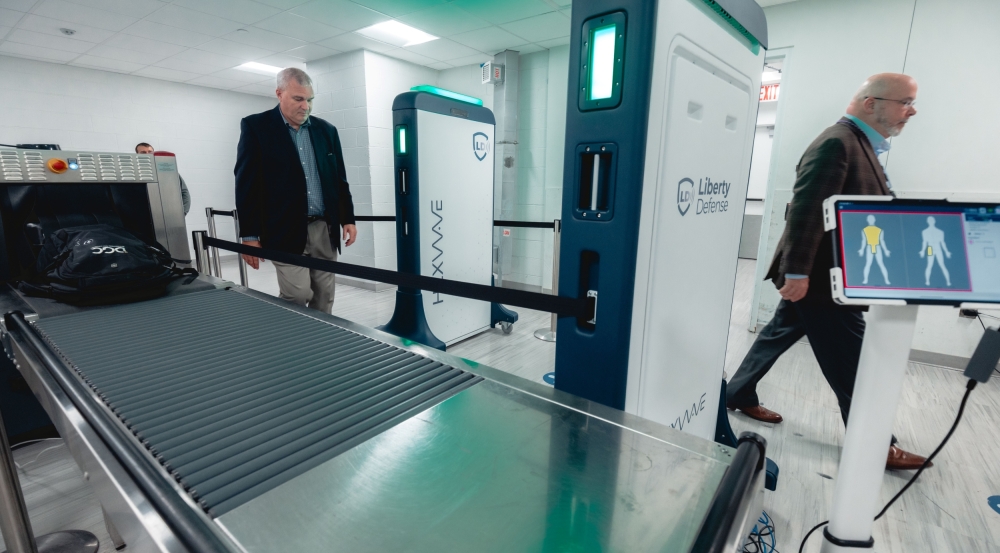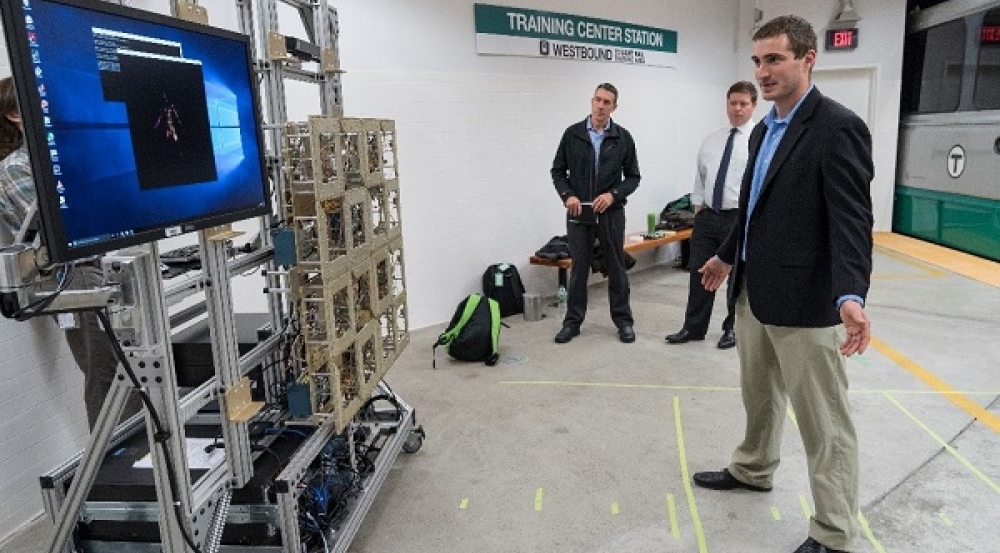Walkthrough screening system enhances security at airports nationwide

A new security screener that people can simply walk past may soon be coming to an airport near you. Last year, U.S. airports nationwide began adopting HEXWAVE — a commercialized walkthrough security screening system based on microwave imaging technology developed at MIT Lincoln Laboratory — to satisfy a new Transportation Security Administration (TSA) mandate for enhanced employee screening to detect metallic and nonmetallic threats. The TSA is now in the process of evaluating HEXWAVE as a potential replacement of metal detectors to screen PreCheck passengers.
Typically, when you arrive at an airport security checkpoint line, you place your carry-on items on the conveyer belt, remove your shoes and any metallic items, and enter a body scanner. As you hold still for a few seconds with your feet spread apart and your arms extended over your head, the scanner creates a generic, featureless 3D body outline revealing any metallic or nonmetallic concealed weapons or other prohibited items.
Requiring individuals to stop, remove clothing and belongings, and pose for scans impedes traffic flow in airports and other highly populated venues, such as stadiums, shopping malls, mass transit stations, and schools. To enable more efficient screening of unstructured crowds and ensure public safety, the Department of Homeland Security (DHS) Science and Technology Directorate (S&T) sponsored Lincoln Laboratory to prototype a high-resolution imaging system capable of scanning people and their belongings as they walk by. This R&D effort was conducted as part of S&T's Surface Transportation Explosive Threat Detection Program, which aims to provide the surface-transportation end user-community (e.g., mass transit) with a layered and integrated capability to detect threat items at the speed of the traveling public.
The Laboratory's prototype microwave imager, which consists of a set of antennas installed on flat panels, operates under the same fundamental principle as existing body scanners: Low-energy radio waves (less powerful than those transmitted by a cell phone) are transmitted from antennas toward a person's body and reflect off skin and any hidden objects; the reflected waves return to the antennas and are processed by a computer to create an image, which security personnel then review to identify any potential concealed threats.
The novelty of the Laboratory's invention lies in its ability to discreetly handle a constant stream of subjects in motion, measuring each subject very quickly (within tens of milliseconds) and reconstructing 3D microwave images of each subject at a video rate. To meet these challenging requirements, the Laboratory team developed a cost-effective antenna array and efficient image-reconstruction algorithms. Compared to existing systems, the Laboratory's 3D microwave imager runs 100 times faster using the same computing hardware. In 2017, the team demonstrated the prototype's ability to detect various simulated threat items at varying distances on a rail platform at the Massachusetts Bay Transmit Authority (MBTA) Emergency Training Center in Boston, Massachusetts.

"The goal of our work is to provide security staff with more effective tools to protect public spaces. To that end, microwave imaging technology can quickly and unobtrusively provide visibility of items carried into a venue," says William Moulder, who led the technology's development at Lincoln Laboratory.
In 2018, the security company Liberty Defense licensed the imaging technology and entered into a Cooperative Research and Development Agreement (CRADA) with Lincoln Laboratory. Transitioning technology to industry for commercialization is part of the Laboratory's role as a federally funded research and development center, and CRADAs provide a mechanism for such transition to happen. Through the CRADA, Liberty Defense maintained Lincoln Laboratory's core image-reconstruction intellectual property and made the technology enhancements required for commercialization, including an entirely new hardware architecture, RF antenna modules, and a transceiver system that meets Federal Communications Commission waveform and RF performance requirements for indoor and outdoor operation. The co-organizational team facilitating the transition of the technology was recognized by the Federal Laboratory Consortium for Technology Transfer (FLC) with a 2019 Excellence in Technology Transfer Award for the Northeast region.
By 2021, Liberty Defense had prototyped a walkthrough security screening system, HEXWAVE. That same year, through the TSA's On-Person Screening Capability Program, Liberty Defense received a contract award to demonstrate HEXWAVE's enhanced threat-detection and high-throughput capabilities for screening aviation workers. Following successful testing of HEXWAVE at sports complexes, entertainment arenas, and shopping centers, both nationally and internationally, Liberty Defense began offering the product for sale.
"HEXWAVE is a great example of how federally funded R&D can be successfully transitioned to industry to meet real-world security needs," says Asha Rajagopal, the Laboratory's chief technology transfer officer. "By working with Liberty Defense, we helped accelerate the delivery of a critical capability into the hands of those protecting public spaces."
In 2023, TSA began testing HEXWAVE as a potential replacement of metal detectors used to screen passengers in TSA PreCheck lanes. Airports across the United States started deploying HEXWAVE in 2024 to meet the TSA's employee screening mandate by the April 2026 deadline. Liberty Defense notes various other markets for HEXWAVE; the first units for commercial applications were delivered to Los Alamos National Laboratory in 2023, and the technology has since been deployed at other national labs, correctional facilities, government buildings, and courthouses.
"Liberty was extremely fortunate to license the technology from MIT Lincoln Laboratory," says Bill Frain, CEO of Liberty Defense. "From the outset, they've been a true partner — bringing not only deep innovation and technical expertise but also a clear vision for commercial deployment. Together, we've successfully brought next-generation technology to market to help protect people in public spaces."
Inquiries: contact Ariana Tantillo.
Related Links